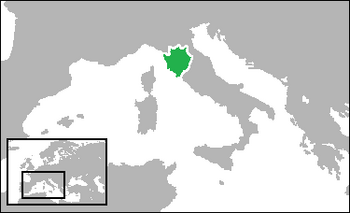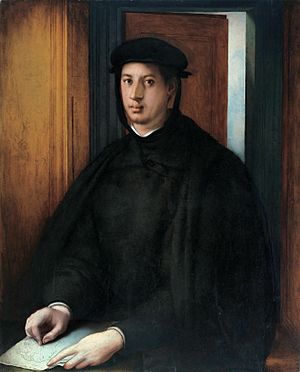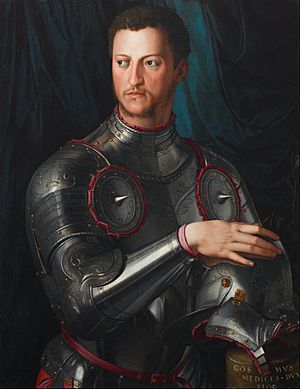Duchy of Florence facts for kids
Quick facts for kids
Duchy of Florence
Ducato di Firenze
|
|||||||||||
|---|---|---|---|---|---|---|---|---|---|---|---|
| 1532–1569 | |||||||||||

The Duchy of Florence (green) in 1557
|
|||||||||||
| Capital | Florence 43°47′N 11°15′E / 43.783°N 11.250°E |
||||||||||
| Common languages | Italian | ||||||||||
| Religion | Catholic Church | ||||||||||
| Government | Despotic monarchy within the Holy Roman Empire | ||||||||||
| Duke of Florence | |||||||||||
|
• 1532–1537
|
Alessandro | ||||||||||
|
• 1537–1569
|
Cosimo I | ||||||||||
| History | |||||||||||
|
• Established
|
1532 | ||||||||||
|
• Battle of Marciano
|
1554 | ||||||||||
|
• Elevated to Grand Duchy
|
1569 | ||||||||||
| Currency | Florin | ||||||||||
|
|||||||||||
The Duchy of Florence (Italian: Ducato di Firenze) was an Italian state that existed from 1532 to 1569. It was located in the city of Florence in Tuscany, Italy. This duchy was created after Emperor Charles V helped bring the powerful Medici family back to power in Florence in 1530.
Pope Clement VII, who was also a Medici, made his relative Alessandro de' Medici the Duke of Florence. This changed Florence from a republic (where people voted) into a hereditary monarchy (where rulers inherited their position). The second Duke, Cosimo I, made Florence stronger by building a navy and expanding its land. In 1569, the Pope gave Cosimo the new title of Grand Duke of Tuscany. The Medici family continued to rule the Grand Duchy of Tuscany until 1737.
Contents
How the Duchy of Florence Began
The Medici family had a lot of influence in Florence since 1434, even without officially ruling. During a big war called the War of the League of Cognac, the people of Florence rebelled against the Medici family. They wanted their republic back.
After a long fight called the Siege of Florence, the city gave up. Emperor Charles V then declared that only he could decide how Florence would be governed. On August 12, 1530, the Emperor made the Medici family the official hereditary rulers of Florence.
Creating a New Government
Pope Clement VII wanted his relative, Alessandro de' Medici, to rule Florence. But he also wanted it to look like the people of Florence had chosen Alessandro themselves. The title "Duke of Florence" was picked because it would make the Medici family even more powerful in the area.
In April 1532, the Pope convinced the Balía, which was Florence's ruling group, to create a new set of rules for the government. These rules officially made Florence a hereditary monarchy. This new system got rid of the old ways of governing, like the signoria (an elected government) and the gonfaloniere (a leader elected for a short time).
Instead, three new groups were created:
- The consigliere: This was a council of four men chosen for three months. The Duke of Florence was their leader.
- The Senate: This group had 48 men chosen by the Balía. They decided on important things like money, safety, and foreign policy for Florence. They also chose people for war and public safety, and governors for other cities.
- The Council of Two Hundred: This group handled requests from the people. Once you were a member, you were a member for life.
Duke Alessandro's Time in Power
Even after Alessandro became Duke, the Emperor's soldiers stayed in Florence. In 1535, some important Florentine families, like the Pazzi family, sent a group to Emperor Charles V. They asked him to remove Alessandro from power. The Pazzi family had tried to kill Lorenzo de' Medici years before.
However, the Emperor did not agree to their request. Charles V had no plans to remove Alessandro because Alessandro was married to Charles's daughter, Margaret of Parma.
Alessandro continued to rule Florence for two more years. He was killed on January 1, 1537, by a distant relative named Lorenzino de' Medici.
Cosimo Becomes Duke and His Rule
Since Alessandro did not have any children who could legally take over, the question of who would rule next was open. In 1537, the leaders of Florence chose Cosimo I. When the exiled Strozzi family heard this, they tried to invade and remove Cosimo from power, but they were defeated in a battle at Montemurlo.
Cosimo completely changed how the government and administration of Florence worked. In 1542, the Emperor's soldiers, who had been in Florence since Charles V's rule, finally left.
Expanding Florence's Power
In 1548, Emperor Charles V gave Cosimo the island of Elba. Cosimo used Elba to build his new navy. He also founded the port city of Livorno and allowed people there to practice any religion they wanted.
Cosimo teamed up with Spain and the Holy Roman Empire. They defeated the Republic of Siena, which was allied with France, in the Battle of Marciano on August 2, 1554. On April 17, 1555, Florence and Spain took over Siena's land. In July 1557, Philip II of Spain gave Siena to Cosimo as a hereditary territory.
The ducal family moved into the grand Palazzo Pitti in 1560. Cosimo also hired the architect Vasari to build the Uffizi, which were offices for the Medici bank. This showed that the Medici family continued to support the arts. In 1569, Pope Pius V gave Cosimo the higher title of Grand Duke of Tuscany. The Medici family continued to rule as Grand Dukes until they died out in 1737.
See also
 In Spanish: Ducado de Florencia para niños
In Spanish: Ducado de Florencia para niños





